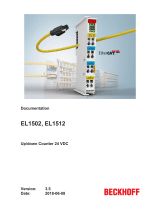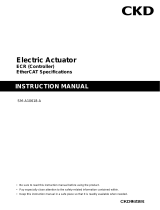
Table of contents
EL72x1-901x4 Version: 1.9
5.1.2 TwinCAT 3 ....................................................................................................................... 70
5.2 TwinCAT Development Environment ..............................................................................................82
5.2.1 Installation of the TwinCAT real-time driver..................................................................... 82
5.2.2 Notes regarding ESI device description........................................................................... 88
5.2.3 TwinCAT ESI Updater ..................................................................................................... 92
5.2.4 Distinction between Online and Offline............................................................................ 92
5.2.5 OFFLINE configuration creation ...................................................................................... 93
5.2.6 ONLINE configuration creation ........................................................................................ 98
5.2.7 EtherCAT subscriber configuration................................................................................ 106
5.3 Start-up and parameter configuration............................................................................................115
5.3.1 Integration into the NC configuration ............................................................................. 115
5.3.2 Settings with the Drive Manager.................................................................................... 119
5.3.3 Settings in the CoE register ........................................................................................... 124
5.3.4 NC settings .................................................................................................................... 128
5.3.5 Application example....................................................................................................... 134
5.3.6 Commissioning without NC, status word/control word................................................... 139
5.3.7 Settings for the automatic configuration ........................................................................ 143
5.3.8 Configuring the limit switch ........................................................................................... 145
5.3.9 Homing .......................................................................................................................... 146
5.3.10 Touch Probe .................................................................................................................. 149
5.4 Operation modes ...........................................................................................................................152
5.4.1 Overview........................................................................................................................ 152
5.4.2 CSV ............................................................................................................................... 152
5.4.3 CST................................................................................................................................ 156
5.4.4 CSTCA........................................................................................................................... 159
5.4.5 CSP ............................................................................................................................... 163
5.5 Profile MDP 742 or DS 402 ...........................................................................................................167
5.6 MDP742 process data ...................................................................................................................167
5.7 DS402 process data ......................................................................................................................171
6 Integrated safety....................................................................................................................................176
6.1 Safety regulations..........................................................................................................................176
6.2 Description of product and function ...............................................................................................176
6.2.1 Intended use .................................................................................................................. 176
6.2.2 Dimensions .................................................................................................................... 177
6.2.3 TwinSAFE reaction times .............................................................................................. 178
6.2.4 Application example for STO function (Cat. 3, PL d) ..................................................... 180
6.3 Maintenance ..................................................................................................................................186
6.4 Service life .....................................................................................................................................186
7 Object description and parameterization............................................................................................188
7.1 EL72x1-9014 (MDP742)................................................................................................................188
7.1.1 Restore object................................................................................................................ 188
7.1.2 Configuration data ......................................................................................................... 188
7.1.3 Configuration data (vendor-specific).............................................................................. 195
7.1.4 Command object............................................................................................................ 195
7.1.5 Input data....................................................................................................................... 195






























